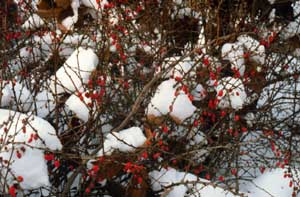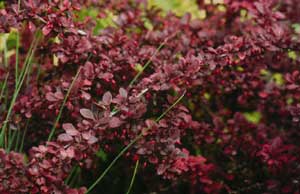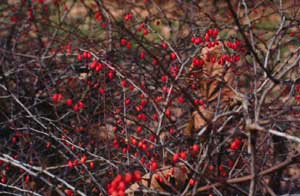 |
Barberry grows all over the United States, everywhere respected as a dependable, versatile shrub. It is no surprise that it is one of the most common landscape plants grown in this country. Barberries are tough and able to adapt to a wide variety of adverse situations, such as urban conditions and dry soil. They have few insect or disease problems. Deer will pass up Japanese barberry in favor of almost any other shrub. Specimen plants may live to 75 years or more. While there are many kinds of barberries, Japanese barberry is regarded as one of the best. Among the hardiest of all the barberries, Japanese barberries are able to handle winters as far north as the Great Lakes region, into upper New York and along the Atlantic coast into Maine (Zone 4). They flourish in regions where winter temperatures seldom dip below -15°F.
Size: Different types of Japanese barberry vary in their height and spread. The tallest grow to 12 feet and spread even wider if left unpruned. Dwarf types may reach only 2 feet in height and spread equally wide. However, the typical Japanese barberry reaches 9 feet at maturity, spreading to 10 feet.
 |
Foliage: Japanese barberries are deciduous, dropping their foliage in the fall after it turns color. The smooth-edged, oval leaves grow in small bunches at the ends of short spurs all along the branches. Sharp thorns emerge from the angle made by the leaf clusters where they join with the stems. Bright green in the spring and summer, the leaves turn to scarlet, orange or yellow in the fall. Some varieties have beautiful purple, yellow, or variegated foliage during the growing season as well, as long as they are in bright sun.
 |
Flowers & Fruit: Barberries have many small yellow or orange waxy flowers about 1/4 inch in diameter. The cup-shaped blooms appear in loose clusters along the branches in mid-spring to early summer, but are not particularly showy. Over the growing season they give way to small red, oblong berries that dangle by short stalks, either singly or in pairs, along the thorny branches. These attractive berries last all winter long, sustaining birds and other wildlife.

